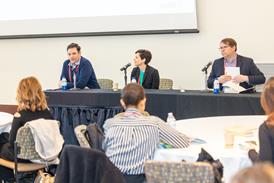- Home
- About CW
-
News
- Back to parent navigation item
- News
- National Compliance Officer Day 2025
- Accounting & Auditing
- AI
- AML
- Anti-Bribery
- Best Practices
- Boards & Shareholders
- Cryptocurrency and Digital Assets
- Culture
- ESG/Social Responsibility
- Ethics & Culture
- Europe
- Financial Services
- Internal Controls
- Regulatory Enforcement
- Regulatory Policy
- Risk Management
- Sanctions
- Surveys & Benchmarking
- Supply Chain
- Third Party Risk
- Whistleblowers
- Opinion
- Events
- Research
- Awards
-
CW Connect
- Back to parent navigation item
- CW Connect
- Sign In
- Apply
- Membership
How FMC Automated Controls to Improve Financial Visibility
By Tammy Whitehouse2013-06-04T00:00:00
Related articles
-
 Premium
PremiumU.K. financial regulator looks to streamline audit enforcement procedures
2025-10-15T19:16:00Z By Ruth Prickett
Auditors are supposed to keep businesses honest, but how much regulation is the optimum for the auditors – and how onerous and punitive should the enforcement regime be? A new consultation by the U.K. regulator, the Financial Reporting Council, opened on Oct. 1 and has put the vexed question of ...
-
 Article
ArticlePCAOB’s Christina Ho: How emerging technologies could improve audit quality
2025-10-07T20:32:00Z By Jaclyn Jaeger
Emerging technologies, like artificial intelligence (AI) and advanced data analytics, can improve audit quality in significant ways. As the regulatory overseer of public-company audits, the Public Company Accounting Oversight Board (PCAOB) has a critical role to play by ensuring that its audit standards evolve as the audit profession evolves.
-
 Webcast
WebcastOct 30 | Compliance Career Forum
Provided by NAVEX
A one-day virtual event exploring how the career path for compliance professionals is changing, and what compliance professionals should be doing now to assure career success and security for years to come.
- Terms and Conditions
- Privacy Policy
- Do Not Sell My Info
- © 2025 Compliance Week
Site powered by Webvision Cloud





